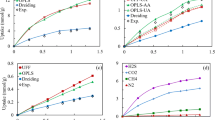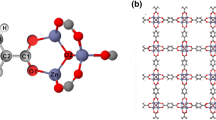Abstract
Using the method of Grand Canonical Monte Carlo we have computed the adsorption of CO2 and CH4 in MOFs with a periodic cubic structure. We used a model of the MOF that allows systematic variations in the charge distribution, size and LJ parameters. We estimated the selectivity of CO2 over CH4 for different temperatures in MOFs with various sizes and charge distributions. The results show that inserting dipoles at the corners of the MOF’s unit cell would increase the selectivity of CO2; on the other hand adding quadrupoles to the structure is ineffective. The size of the cell strongly affects the adsorption of CO2 and selectivity: compressing the cell in only 10 % significantly increases the selectivity; expanding the cell by 20 % reduces it. Regarding thermal effects, we estimated that the selectivity drops from 250 to 2 when the temperature rises from 120 K to 300 K. Although this model is inspired by the IRMOF-1, which has a cubic unit cell, it can be adapted to represent other MOFs with noncubic structures by modifying the geometry accordingly. This work implies that MOFs suit gas separation.












Similar content being viewed by others
References
D. Singh, E. Croiset, P.L. Douglas, M.A. Douglas, Energy Convers. Manag. 44, 3073 (2003)
C.M. White, D.H. Smith, K.L. Jones, A.L. Goodman, S.A. Jikich, R.B. LaCount, S.B. DuBose, E. Ozdemir, B.I. Morsi, K.T. Schroeder, Energy Fuels 19, 659 (2005)
D.M. Ruthve, S. Farooq, K. Knaebel, Pressure Swing Adsorption (VCH, New York, 1994)
S. Sircar, Ind. Eng. Chem. Res. 45, 5435–5448 (2006)
D. Britt, D. Tranchemontagne, O.M. Yaghi, Proc. Natl. Acad. Sci. USA 105, 11623–11627 (2008)
Carbon Capture Research, Publication of the Department of Energy. http://www.fossil.energy.gov/programs/sequestration/capture/index.html. Accessed 10 October 2012
N.W. Ockwig, T.M. Nenoff, Chem. Rev. 107, 4078–4110 (2007)
R.T. Yang, Chem. Eng. 1 (1997)
M. Eddaoudi, J. Kim, N. Rosi, D. Vodak, J. Wachter, M. O’Keeffe, O.M. Yaghi, Science 295, 479 (2002)
M.J. Bennet, J.V. Smith, Mater. Res. Bull. 3, 633 (1968)
T. Düren, R.Q. Snurr, J. Phys. Chem. B 108, 15703 (2004)
J.A. Greathouse, T.L. Kinnibrugh, M.D. Allendorf, Ind. Eng. Chem. Res. 48, 3425–3431 (2009)
K.S. Walton, A.R. Millward, D. Dubbeldam, H. Frost, J.J. Low, O.M. Yaghi, R.Q. Snurr, J. Am. Chem. Soc. 130, 406 (2008)
D. Dubbeldam, H. Frost, K.S. Walton, R.Q. Snurr, Fluid Phase Equilib. 261, 152 (2007)
S. Keskin, D.S. Sholl, J. Phys. Chem. C 111, 14055 (2007)
R. Babarao, Z. Hu, J. Jiang, S. Chempath, S.I. Sandler, Langmuir 23, 659 (2007)
S. Keskin, J. Liu, R.B. Rankin, J.K. Johnson, D.S. Sholl, Ind. Eng. Chem. Res. 48, 2355 (2009)
B. Smit, D. Frenkel, Understanding Molecular Simulation. Computational Science Series, vol. 1 (Academic Press, London, 2001)
S.M. Gatica, M.J. Bojan, G. Stan, M.W. Cole, J. Chem. Phys. 114, 3765 (2001)
R.O. Watts, I.J. McGee, Liquid State Chemical Physics (Wiley, New York, 1976)
G.C. Maitland, M. Rigby, E.B. Smith, W.A. Wakeham, Intermolecular Forces: Their Origin and Determination (Clarendon, Oxford, 1987). Tables A 3.1 and A 3.2, pp. 565–566
L.W. Bruch, M.W. Cole, E. Zaremba, Physical Adsorption: Forces and Phenomena (Dover, Mineola, 2007), p. 67. (Reprint of 1997 Oxford U. P. edition)
T. Duren, L. Sarkisov, O.M. Yaghi, R.Q. Snurr, Langmuir 20, 2683–2689 (2004)
M. Bienfait, P. Zeppenfeld, N. Dupont-Pavlovsky, M. Muris, M.R. Johnson, T. Wilson, M. DePies, O.E. Vilches, Phys. Rev. B 70, 035410 (2004)
A.R. Millward, O.M. Yaghi, J. Am. Chem. Soc. 127, 17998 (2005)
A.L. Myers, J.M. Prausnitz, AIChE J. 11, 121 (1965)
R.T. Yang, Gas Separation by Adsorption Processes (Butterworths, Boston, 1987)
Acknowledgements
This research was supported by the Donors of the American Chemical Society Petroleum Research Fund and NSF DMR1006010. We thank Milton Cole for his helpful comments.
Author information
Authors and Affiliations
Corresponding author
Appendix
Appendix
For a system with two phases in equilibrium, like the case of an adsorbate in equilibrium with its vapor, the chemical potential of each phases are equal,

At very low coverage, the adsorbate may be approximated by an ideal gas. Assuming that there is only one kind of adsorption site of energy −ε, the chemical potential of a 3-dimensional adsorbate is

where n is the coverage and λ=(h 2/(2πmk B T))1/2 is the thermal wavelength.
Assuming that the vapor is an ideal gas as well,

where P is the equilibrium vapor pressure. Equating (A.2) and (A.3), we obtain

Using the definition of q st given in (5), it results

Following the same steps for a 2-dimensional adsorbate, in which case μ ads=−ε+k B Tln(nλ 2) we obtain

For a one-dimensional adsorbate, for example the atoms adsorbed in the groove of a bundle of nanotubes, the result is

given that in this case μ ads=−ε+k B Tln(nλ).
Rights and permissions
About this article
Cite this article
Maiga, S.M., Medina, M.A., Durodola, O.J. et al. Simulations of Adsorption of CO2 and CH4 in MOFs: Effect of the Size and Charge Distribution on the Selectivity. J Low Temp Phys 172, 274–288 (2013). https://doi.org/10.1007/s10909-013-0864-z
Received:
Accepted:
Published:
Issue Date:
DOI: https://doi.org/10.1007/s10909-013-0864-z




